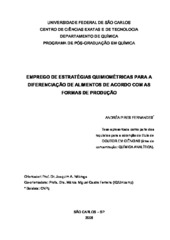Emprego de estratégias quimiométricas para a diferenciação de alimentos de acordo com as formas de produção.
Abstract
The application of pattern recognition techniques such as principal component analysis and cluster analysis was evaluated for classification of foods according to their production mode (industrial or homemade and organically or conventionally produced), refine mode or geographical source. The main variables were the mineral contents of samples of coffee (roasted and green), vegetables, legumes, sugar, milk, sugar-cane spirit, beans, and rice. The concentrations of metals were determined by ICP OES or by GF
AAS after microwave-assisted digestion or dilution. Other variables, such as nitrate
and crude protein contents, were determined in vegetables and legumes samples. Nuclear magnetic resonance of 1H was applied to green coffee and beans to attempt to correlate chemical classes with production mode. Separations were obtained for differentiation between organic and conventional green coffees, and between instant
soluble and roasted coffees. Attempts to correlate metals contents with geographical sources for coffee and sugar samples, and metals contents and production mode for vegetables, legumes, milks, sugar cane spirits, and rices were not successful. However, differentiation was observed for lettuces and cachaças based on geographical source, and for sugar samples based on the refine mode. Additionally, differentiation was also observed for lettuce samples based on the production mode, and nitrate was the main variable for differentiation. It was observed a trend towards the classification of beans according to the production mode based on NMR data set, however it is necessary to identify the chemical compounds that led to differentiation.
According to these results, pattern recognition analyses were able to differentiate some important features in different samples based on their metals contents. Additionally, taking into account metals contents there was no appreciable difference between organically and conventionally produced foods.
